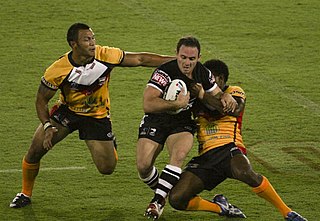
Rugby league football, commonly known as rugby league in English-speaking countries and rugby XIII in non-Anglophone Europe and South America, and referred to colloquially as football, footy or league in its heartlands, is a full-contact sport played by two teams of thirteen players on a rectangular field measuring 68 m (74 yd) wide and 112–122 m (122–133 yd) long with H-shaped posts at both ends. It is one of the two major codes of rugby football, the other being rugby union. It originated in 1895 in Huddersfield, Yorkshire, England, as the result of a split from the Rugby Football Union (RFU) over the issue of payments to players. The rules of the game governed by the new Northern Rugby Football Union progressively changed from those of the RFU with the specific aim of producing a faster and more entertaining game to appeal to spectators, on whose income the new organisation and its members depended.
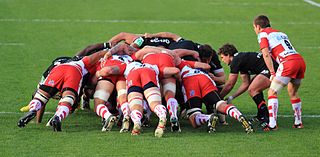
A scrummage, commonly known simply as a scrum, is a method of restarting play in rugby football that involves players packing closely together with their heads down and attempting to gain possession of the ball. Depending on whether it is in rugby union or rugby league, the scrum is used either after an accidental infringement or when the ball has gone out of play. Scrums occur more often, and are now of greater importance, in union than in league. Starting play from the line of scrimmage in gridiron football is derived from the scrum.

In the game of rugby union, there are 15 players on each team, comprising eight forwards and seven backs. In addition, there may be up to eight replacement players "on the bench", numbered 16–23. Players are not restricted to a single position, although they generally specialise in just one or two that suit their skills and body types. Players that play multiple positions are called "utility players".
A rugby league team consists of 13 players on the field, with 4 substitutes on the bench. Each of the 13 players is assigned a position, normally with a standardised number, which reflects their role in attack and defence, although players can take up any position at any time.

Stacey William Jones is a New Zealand former professional rugby league footballer, who has been named amongst the greatest New Zealand has ever produced. He is currently the head coach of New Zealand national team. He played as a halfback, but he has also briefly played at five-eighth during his distinguished career, which includes 46 Tests for New Zealand (1995–2006). Stacey Jones is the first and only life member of the New Zealand Warriors club whose records for most appearances, tries and points he held at the time of his retirement.
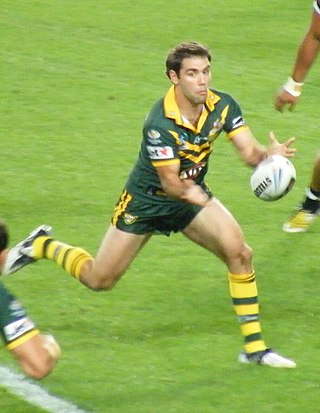
Like most forms of modern football, rugby league football is played outdoors on a rectangular grass field with goals at each end that are attacked and defended by two opposing teams. The rules of rugby league have changed significantly over the decades since rugby football split into the league and union codes. This article details the modern form of the game and how it is generally played today, although rules do vary slightly between specific competitions.

Thomas Leon Preston Campbell is an Australian former professional rugby league footballer who played as a five-eighth or fullback in the National Rugby League (NRL) for the Cronulla-Sutherland Sharks, the Penrith Panthers and the Gold Coast Titans. He was also a New South Wales Country, Dreamtime Team and Indigenous All Stars representative.

Shaun Berrigan is an Australian former professional rugby league footballer who played as a hooker, centre, halfback and five-eighth in the 1990s, 2000s, and 2010s.
Nathan Fien, also known by the nickname of "Fieny", is an Australian professional rugby league assistant coach with the Dolphins since their inaugural 2023 season in the National Rugby League (NRL) competition.

Geoffrey Toovey, also known by the nickname of "Toovs" or "Tooves", is the former head coach of the Bradford Bulls and former professional rugby league footballer. Toovey played halfback for the Manly-Warringah Sea Eagles, then played as a hooker later in his career at the Northern Eagles. He played 286 first-grade matches in all, and captained Manly to the 1996 ARL premiership and the 1995 and 1997 grand finals. He played in 13 international matches for Australia between 1991 and 1998. Toovey is the former head coach of Manly-Warringah.
Rugby league football has accrued considerable jargon to describe aspects of the game. Many terms originate in the Laws of the Game. Some aspects of the game have more than one term referring to them. Different terms have become popularly used to describe an aspect of the game in different places, with notable differences between the Northern and Southern Hemispheres.

Fullback is one of the positions in a rugby league football team. Typically wearing jersey number 1, the fullback is a member of the team's 'back-line'. The position's name comes from their duty of standing the furthest back in defence, behind the forwards (8-13), half backs and the three-quarter backs (2-5). Fullbacks are therefore the last line of defence, having to tackle any opposition players and regather the ball from any kicks that make it through their teammates. It is for this reason that the fullback is also referred to as the sweeper or custodian. Being able to secure high bomb kicks is a highly sought quality in fullbacks.

Rugby league match officials are responsible for fairly enforcing the Laws of the Game from a neutral point of view during a match of rugby league football and imposing penalties for deliberate breaches of these Laws. The most senior match official is the referee. They may be assisted by a range of other officials depending on the level and rules of the competition.

The 2006 NRL Grand Final was the conclusive and premiership-deciding match of the NRL's 2006 Telstra Premiership season. It was played between the first-placed Melbourne Storm and the third-placed Brisbane Broncos clubs on the night of Sunday, 1 October. The 2006 grand final was the first ever to feature teams which were both from cities outside the borders of New South Wales, in this case the capitals of Queensland and Victoria, yet was played at the traditional venue of Sydney's Telstra Stadium. It was the first time the two sides had met in a grand final. They had played each other twice during the 2006 regular season, with Melbourne winning both times. The Melbourne side went into the grand final as heavy favorites, having won the minor premiership. Both teams were looking to keep their perfect grand final records intact: Brisbane with 5/5 and the Melbourne side with 1/1 heading into the game.
In rugby league football, the Laws of the Game are the rules governing how the sport is played. The Laws are the responsibility of the Rugby League International Federation, and cover the play, officiating, equipment and procedures of the game.
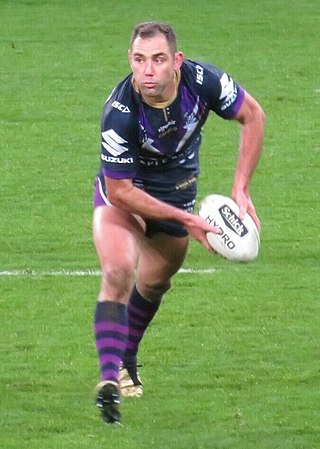
Hooker is one of the positions in a rugby league football team. Usually wearing jersey or shirt number 9, the hooker is one of the team's forwards. During scrums the hooker plays in the front row, and the position's name comes from their role of 'hooking' or 'raking' the ball back with the foot. For this reason the hooker is sometimes referred to in Australia as the rake. Hookers have a great deal of contact with the ball, as they usually play the role of acting halfback or dummy half, picking the ball up from the play-the-ball that follows a tackle. Hookers therefore have much responsibility in that they then decide what to do with the ball, whether that be to pass it, run with it, or occasionally to kick it. Therefore, together with the two halves and fullback, hooker is one of the four key positions that make up what is sometimes called a team's 'spine'. A trend of halves converting into hookers followed the introduction of the 10 metre rule, and many players have switched between these positions in their careers such as Geoff Toovey, Andrew Johns, Craig Gower and Peter Wallace.

Michael Morgan is an Australian former professional rugby league footballer who played in the NRL.

Jacob Miller is an Australian professional rugby league footballer who plays as a stand-off or scrum-half for the Castleford Tigers in the Super League.

Dylan Walker is a professional rugby league footballer who plays as a lock for the New Zealand Warriors in the National Rugby League (NRL), and has played for Australia and the New Zealand Maori at international level.
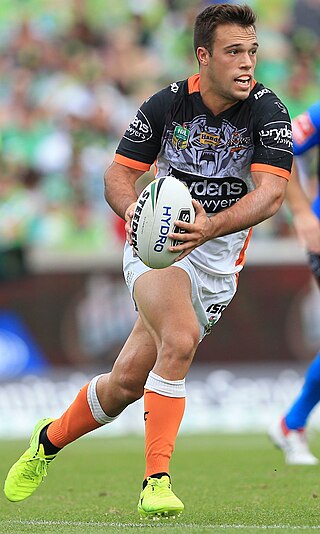
Luke Brooks is an Australian professional rugby league footballer who plays as a five-eighth for the Manly Warringah Sea Eagles in the National Rugby League (NRL) in 2024. He previously played for the Wests Tigers in the NRL as a halfback. He made an appearance for the NRL in 2015.

















